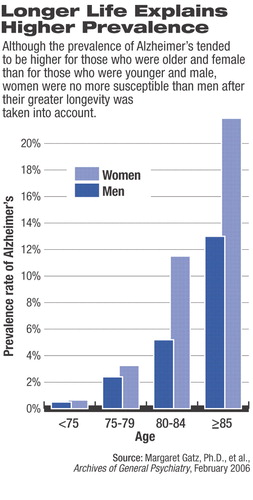Twin Study Spotlights Alzheimer's Genetic Link
Alzheimer's disease is inherited to a substantial degree, a twin study believed to be the largest conducted on this topic has revealed.
The investigation was headed by Margaret Gatz, Ph.D., a professor of psychology at the University of Southern California. Results were published in the February Archives of General Psychiatry.
Some 12,000 twin pairs enrolled in the Swedish twin registry, of which 392 had one or both members with Alzheimer's, served as a data source. When identical twins are more concordant for a disease than fraternal twins, genetic influences are suggested. So Gatz and her colleagues looked to see whether identical-twin pairs were more similar in risk for developing Alzheimer's than fraternal twin pairs were. The answer was yes.
Genes Play a Role
The concordance rate among identical twins was 83 percent, whereas it was only 46 percent for fraternal twins. So, genes play a role in Alzheimer's susceptibility, Gatz and her group concluded.
Furthermore, when they took the genes, shared environment, and nonshared environments of the twins into consideration, they found that 58 percent of individual differences in Alzheimer's could be explained by genes, 19 percent by a shared environment, and 23 percent by a nonshared environment.
“Previous twin studies have presented estimates [for Alzheimer's genetic susceptibility] that vary quite a bit from each other,” Gatz told Psychiatric News. “[Thus] I was surprised by how consistent we were with the heritability estimates found before by a smaller sample of Swedish twins and by the Norwegian twin registry [and] also how consistent we were in concordance rates for identical twins with the New York State Psychiatric Institute results for `senile dementia' from decades ago.”

Indeed, one of the scientists who conducted this latter study—Lissy Jarvik, M.D., Ph.D., a professor emeritus of psychiatry at the University of California at Los Angeles—said that she was pleased that Gatz and colleagues had obtained a “dementia concordance rate for monozygotic pairs very similar to that reported by us.. .back in 1956.”
Alzheimer's More Prevalent in Women
Another salient result to emerge from the study was that Alzheimer's was more prevalent among women than men; yet once women's greater longevity was taken into account, women were no more susceptible than men were.
Also of note, when the investigators focused on twin pairs concordant for Alzheimer's, they found that the intra-pair difference in age at onset was significantly greater in fraternal twins than in identical twins—an average of eight years versus four years. Therefore, because the age of onset was more similar among identical twins, one can conclude that genes not only influence whether people will develop Alzheimer's, but when.
Nonetheless, as the study results make clear, Alzheimer's risk and timing are also influenced by nongenetic factors, and scientists may have identified a few of those factors, Gatz said.
For example, brain injury and high cholesterol appear to predispose people to Alzheimer's, whereas higher education levels seem to help shield them from it. In fact, “higher education has been found in many, many studies to be related to lower risk of Alzheimer's disease,” she pointed out.“ We have found this to be true even within identical-twin pairs [in which] one has developed Alzheimer's disease and the twin sibling has not.”
Yet undoubtedly, a “multitude of factors... protect against (or promote) the development of Alzheimer's,” Jarvik asserted, and“ twin studies could contribute significantly to the assessment of the effectiveness of changes in diet, exercise... and the like in preventing or postponing Alzheimer's.”
And the people who stand to profit most from the identification of prevention measures are the millions of Americans whose parents had Alzheimer's. “They are deeply concerned about their risk of developing Alzheimer's disease, but there are as yet no data to determine specific risk of Alzheimer's in children of Alzheimer's parents.”
The study was funded by the National Institute on Aging and the Alzheimer's Association.
An abstract of “Role of Genes and Environments for Explaining Alzheimer Disease” is posted at<http://archpsyc.ama-assn.org/cgi/content/abstract/63/2/168>.▪
Arch Gen Psychiatry 2005 63 168



